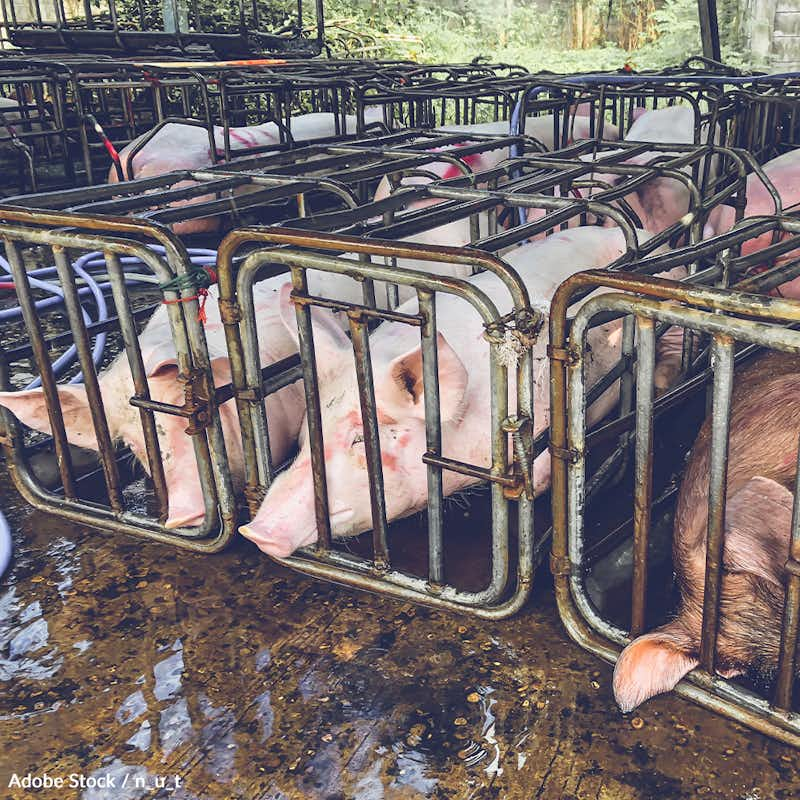Stop Disasters From Claiming Millions of Forgotten Farm Animals
12,054 signatures toward our 30,000 Goal
Sponsor: The Animal Rescue Site
When disasters strike, farm animals are too often left behind to die. Help us ask the government to implement farm safety plans and save millions of animal lives!

When natural disasters strike, animal shelters can find themselves overwhelmed with pets, while dealing with reduced or damaged facilities. There are federal resources that support the rescue and care of household pets, but many other animals are being left behind to face a horrific death.
The Federal Emergency Management Agency (FEMA) has several Individual Assistance programs designed to support disaster survivors and household pets1, under the PETS Act2 passed in 2006 shortly after Hurricane Katrina.
This law requires that states “account for the needs of individuals with household pets and service animals before, during, and following a major disaster or emergency.” Since then, more than 30 states have amended their disaster relief plans to account for the needs of companion animals and service animals.
However, the PETS Act only provides for certain companion animals — namely service animals and those that FEMA calls “household pets.” This includes dogs, cats, birds, rabbits, rodents, and turtles, but excludes reptiles other than turtles, fish, amphibians, farmed animals, horses, and others3.
There are no laws protecting farmed animals in emergencies or natural disasters4.
At least 3.4 million chickens and turkeys and more than 5,500 pigs died during Hurricane Florence in 20185, even higher than those animal deaths reported when Hurricane Matthew decimated the same area a few years earlier6.
More than 9 million pigs were at risk, but no laws required farmers to have a contingency plan in place to even consider the welfare of those pigs, let alone requiring them to move those animals to safety7.
These animals drowned in the floodwaters or starved when food and water rations ran out or automated systems failed. An unknown number of animals suffered from injury and diseases following the storms and may have died later or been killed in order to be included in insurance claims. Owners left the barns locked so that the animals would drown so they could collect on the insurance8.
The contamination from multiple breached hog waste lagoons was still being cleaned up years later, by which time the waste had killed an unknown number of fish and other wildlife9.
Having thousands of animals on one farm makes it impossible to design reasonable evacuation or mitigation plans, so farmed animals are locked in sheds—often in cages and crates—where they’re unable to flee the rising floodwaters10.
Guidance from federal government on safe evacuation plans for factory farms11 would help prevent millions of senseless animal deaths when disasters strike, a pressing need as climate change is increasing the frequency of hurricanes and other natural disasters12.
Sign the petition and call for the federal government to take action and save the lives of farm animals when disasters strike.
- Federal Emergency Management Agency (FEMA) (28 October 2022), "Programs to Support Disaster Survivors."
- Rep. Tom Lantos, 109th Congress (6 October 2006), "H.R.3858 - Pets Evacuation and Transportation Standards Act of 2006."
- The Animal Legal Defense Fund, "The PETS Act: Companion Animals Affected by Natural Disasters."
- Cheryl Leahy, Animal Outlook (15 April 2021), "Does The Law Protect Farmed Animals?."
- John Murawski, The News & Observer (19 September 2018), "Florence kills 5,500 pigs and 3.4 million chickens. The numbers are expected to rise.."
- Tom Philpott, Mother Jones (14 October 2016), "Hurricane Matthew Killed Millions of Farm Animals in North Carolina."
- Alexandra Isfahani-Hammond, CounterPunch (21 September 2018), "Hurricane Florence and 9.7 Million Pigs."
- Julie Cappiello, World Animal Protection (21 May 2020), "New NOAA Study Says Hurricanes Are Getting Stronger. Here’s What That Means for Farmed Animals.."
- Wynne Davis, NPR (22 September 2018), "Overflowing Hog Lagoons Raise Environmental Concerns In North Carolina."
- The Humane Society of the United States (2022), "Livestock disaster preparedness."
- University of Minnesota Extension, Regents of the University of Minnesota (2021), "Creating farm emergency action plans."
- The Earth Observatory, NASA (30 March 2005), "The Impact of Climate Change on Natural Disasters."
The Petition:
To the Administrator of the Federal Emergency Management Agency (FEMA),
There are currently no laws protecting farm animals during a disaster, and millions of animals have faced horrific deaths as a result.
Millions of animals perished in Hurricane Matthew in 2016, and At least 3.4 million chickens and turkeys and more than 5,500 pigs died during Hurricane Florence in 2018.
More than 9 million pigs were at risk, but no laws required farmers to have a contingency plan in place to even consider the welfare of those pigs, let alone requiring them to move those animals to safety
These animals drowned in the floodwaters or starved when food and water rations ran out or automated systems failed. An unknown number of animals suffered from injury and diseases following the storms and may have died later or been killed in order to be included in insurance claims. Owners left the barns locked so that the animals would drown so they could collect on the insurance.
We need federal recommendations for safe evacuation of farms of all sizes, support to ensure those plans can be carried out would help prevent millions of senseless animal deaths when disasters strike, a pressing need as climate change is increasing the frequency of hurricanes and other natural disasters.
I implore you to take immediate action in addressing these shortcomings before the next disaster puts millions more lives at risk
Sincerely,